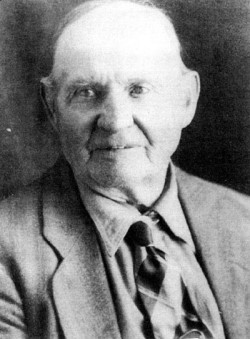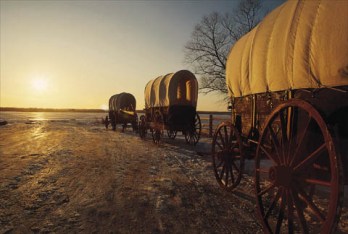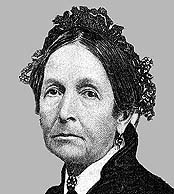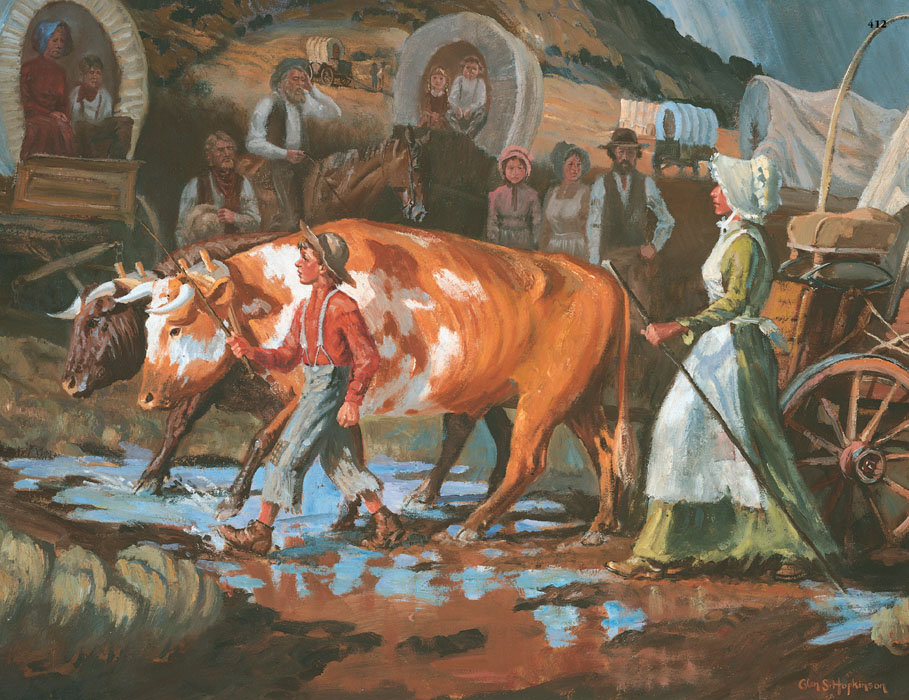(Editor’s note- The man pictured above is actually Moses Harris’s grandson William Moses Harris.)
Moses Harris is my great-great-great grandfather. I’ll admit it, I’m a genealogy buff and I go above and beyond the normal seeking out of ancestors. I try to find journals, newspaper articles, wills, obituaries, family bibles, letters . . . anything I can find to help me realize these men and women who trod this world before us were once real, living, breathing human beings.
One of these is Grandpa Moses, as I like to call him. He was born July 20th, 1798 in Fitch, Pennsylvania. I assume Grandpa Moses grew up like other young men of his day, carving out a livelihood in the new America. John Adams had just replaced George Washington as president of the United States. The newly ratified U.S. Constitution was eleven years old and the country was still feeling its growing pains.
Prior to January 1, 1824, when he married his sweetheart, Fanny Smith, he was in conversation with his future father-in-law, Thomas Dodd Smith. His father-in-law explained to him that the true church was not on the face of the earth at this time, but that it would come during Moses’ and Fanny’s lifetime. He begged Moses to not forget his future wife’s parents when the time came.
This was so important to Grandpa Thomas, that he spoke of this, once more, to Moses before he married Fanny.
On February 24, 1833 Moses and Fanny were baptized into The Church of Jesus Christ of Latter-day Saints. Grandpa Thomas died in 1829, one year before the restoration and organization of The Church of Jesus Christ of Latter-day Saints, and Grandma Keziah died sometime within the next decade. But Moses did not forget the promise to his father-in-law, and he and Fanny were baptized for her parents, and then performed the temple ordinances for them when those became available.
My great-great-great-great grandparents were driven from state to state, along with the rest of the saints. They lost three children to the mobs of Missouri. They settled in Montrose, Iowa, right across the river from Nauvoo. (Montrose is where the prophet, Joseph Smith, Jr., was fleeing prior to his last arrest. But that’s an entirely different sequence of events.) When the saints had to leave Nauvoo, Moses packed up his family once more and they started west. Moses was very ill during this journey, and yet when the U.S. Army (whose nerve knew no bounds) showed and demanded their healthiest men to fight in the Mexican American War, Moses sent his son, Silas Harris, to fight in the Mormon Batallion.
Once the family was reunited, they continued west and settled in the Salt Lake valley until they were asked by Brigham Young to go settle the San Bernadino valley. Moses and his family relocated without complaint. They were very close to paying off their properties in San Bernardino when Black Hawk started his raids. Brigham Young ordered all the Latter-day Saints to leave that area, and once again, without complaint, Moses packed up his family and moved to settle the new area, Harrisville (which later became Harrisburg), Utah. Harrisburg is located in southern Utah, 15 miles north of St. George, and is now a ghost town.
From his obituary we learn a little more of the type of man my great-great-great-grandfather was:
Obituary of Moses Harris
Deseret Evening News
March 27, 1890, page 3:DEATH OF MOSES HARRIS.
Yet Another Aged Veteran Passes Away.
Moses Harris, the subject of this sketch, was born July 20th, 1798, in Somerset County Pennsylvania. He was the son of Silas and Annaretta Wright Harris. His Ancestor was among the first of New England. In an early day his father moved into Indiana and settled in Cork County. There Moses became acquainted with Fanny Smith, whom he married Jan. 1st, 1824, and who still survives him, aged 86 years. Both were baptized into the Church of Jesus Christ of Latter-day Saints on February 23rd, 1833. He, in company with his brother-in-law, Samuel Hawks, gathered with the Saints in Missouri in the summer of 1836, and stopped through the winter of 1836 and ’37 at Charlton, Missouri, and in the following spring located on Crooked River, Caldwell County. He suffered with the Saints in the persecution of 1838, and in the inclement months of March, 1839, with a one-hose wagon, in which had be stowed the most necessary household goods, with several children, he set out for Illinois, leaving all the balance of their property a prey to the mobbers.
He finally settled about five miles west of Montrose, Iowa, in a very destitute condition. He was ordained a High Priest under the direction of the Prophet Joseph Smith in Nauvoo.
The season before the exodus of the Saints from Illinois he moved on a farm nearer Montrose which he had retained. About the first of May, 1846, he took up the line of march with the Saints for the West, and arrived at Council bluffs about the time that Colonel Allen called on the Twelve for 500 volunteers to go to California. He gave up his eldest son, Silas, who was the main support of the family in response to the call of the Twelve, to enlist in the battalion. At the Bluffs he located on Little Pidgeon Creek. In October, 1848, his son arrived from California and, with his assistance, the family were prepared to cross the plains in R.N. Allred’s company, in 1849. After they had crossed the Loup Fork, his sister, the wife of William Hawk, was killed in a stampede.
He arrived in Salt Lake valley on the 16th of October and settled in Bountiful, ten miles north of Salt Lake City, where he remained until the spring of 1851, when he joined the company of Charles C. Rich and Amaza Lyman to go to San Bernardino to form a settlement. At that place he purchased forty acres of land at #10 per acre, but not having it quite paid for when the settlement was broken up, he got no title for it and so lost it with the improvements he had made. He started on his return to Utah in the fall of 1857 in Jefferson Hunt’s company, and settled in Washington, Washington County, Utah, in February, 1858. In the spring of 1859 he moved to Harrisburg, which place was named after him by President Brigham Young, he being the only settler there at that time.
In May 1864 he moved with his son John to Berry Valley (now Long Valley), Kane County, Utah, and located at what is now the town of Glendale, where he remained until driven out by the Indians in June 1867. HE returned to Harrisburg where he remained about three years, and then assisted in building up the town of Leeds, three miles eat of Harrisburg. From this place he moved back to Glendale, Long Valley, and settled near his son Silas, at which place he departed this life March 15th, 1890, after an illness of thirty days, caused by an attack of influenza, which settled in his stomach, causing severe pain. He finally passed peacefully away a few minutes before midnight, aged 91 years, 7 months and 25 days.
He leaves a posterity now living of five children, [55] grandchildren. Father Harris’ long and eventful life, after gathering with the Saints in Missouri, was mostly spent in opening up new settlements. He was very unassuming, and was honest and upright in his dealings with his fellow man, always quietly performing all duties required of him. He was very temperate in his habits. He never faltered nor murmured under all the trying scenes he was called to pass through, and was ever ready to bear a strong testimony to the truth of this Latter-day work. It can truly be said of him, “He has fought the good flight, he has kept the faith,” and will come forth in the morning of the first resurrection and inherit all the blessings sealed upon his head in the Temple of the Lord, wherein he passed through all the ordinances given in those sacred places.
WARREN FOOTE.
I am of that posterity. People ask me why I strive to accomplish so much. They ask me why I love the gospel and our Savior, Jesus Christ so much. They ask me why I am so devoted to my family and friends. Being descended from Moses Harris, could I do or be any less?







The picture with this “Moses Harris: Utah Pioneer and Man of God” is not the Moses Harristhat is written here. This picture is William Moses Harris (1865-1959). He is the grandson of the Moses Harris. This needs to be corrected.
We will check this out. Thanks, Kathleen.
moses harris is also my 3 times great grand father.i am a descendant of william jones harris//his youngest son.i have traced the harris line to the 1300s in dumphries ireland to england to being one of the first families in america..my contact info is below if candace wants to contact me
Kathleen miles
i would appreciate it if you would contact me I have a few questions if you have time.thank you
The author of this article was a volunteer and has since moved on. We don’t have any contact information for her, I’m sorry.
Vaughn I would love to connect regarding your research up the line. Moses Harris is also my 3x great grandfather, I’m a descendant of his son Silas. [email protected]
I’m sincerely sorry, but this article was written by a writer who has moved on to other endeavors and didn’t leave any forwarding information.
This picture is his grandson William Moses Harris
Thank you! I’ll correct that right away.